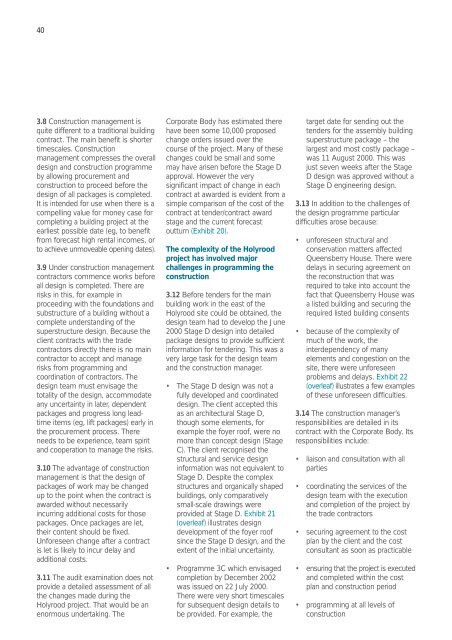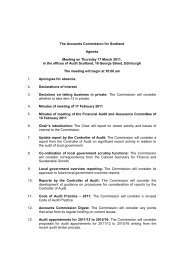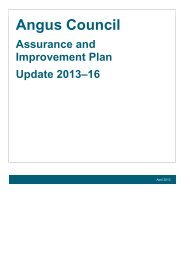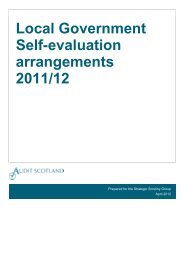Management of the Holyrood building project (PDF ... - Audit Scotland
Management of the Holyrood building project (PDF ... - Audit Scotland
Management of the Holyrood building project (PDF ... - Audit Scotland
Create successful ePaper yourself
Turn your PDF publications into a flip-book with our unique Google optimized e-Paper software.
40<br />
3.8 Construction management is<br />
quite different to a traditional <strong>building</strong><br />
contract. The main benefit is shorter<br />
timescales. Construction<br />
management compresses <strong>the</strong> overall<br />
design and construction programme<br />
by allowing procurement and<br />
construction to proceed before <strong>the</strong><br />
design <strong>of</strong> all packages is completed.<br />
It is intended for use when <strong>the</strong>re is a<br />
compelling value for money case for<br />
completing a <strong>building</strong> <strong>project</strong> at <strong>the</strong><br />
earliest possible date (eg, to benefit<br />
from forecast high rental incomes, or<br />
to achieve unmoveable opening dates).<br />
3.9 Under construction management<br />
contractors commence works before<br />
all design is completed. There are<br />
risks in this, for example in<br />
proceeding with <strong>the</strong> foundations and<br />
substructure <strong>of</strong> a <strong>building</strong> without a<br />
complete understanding <strong>of</strong> <strong>the</strong><br />
superstructure design. Because <strong>the</strong><br />
client contracts with <strong>the</strong> trade<br />
contractors directly <strong>the</strong>re is no main<br />
contractor to accept and manage<br />
risks from programming and<br />
coordination <strong>of</strong> contractors. The<br />
design team must envisage <strong>the</strong><br />
totality <strong>of</strong> <strong>the</strong> design, accommodate<br />
any uncertainty in later, dependent<br />
packages and progress long leadtime<br />
items (eg, lift packages) early in<br />
<strong>the</strong> procurement process. There<br />
needs to be experience, team spirit<br />
and cooperation to manage <strong>the</strong> risks.<br />
3.10 The advantage <strong>of</strong> construction<br />
management is that <strong>the</strong> design <strong>of</strong><br />
packages <strong>of</strong> work may be changed<br />
up to <strong>the</strong> point when <strong>the</strong> contract is<br />
awarded without necessarily<br />
incurring additional costs for those<br />
packages. Once packages are let,<br />
<strong>the</strong>ir content should be fixed.<br />
Unforeseen change after a contract<br />
is let is likely to incur delay and<br />
additional costs.<br />
3.11 The audit examination does not<br />
provide a detailed assessment <strong>of</strong> all<br />
<strong>the</strong> changes made during <strong>the</strong><br />
<strong>Holyrood</strong> <strong>project</strong>. That would be an<br />
enormous undertaking. The<br />
Corporate Body has estimated <strong>the</strong>re<br />
have been some 10,000 proposed<br />
change orders issued over <strong>the</strong><br />
course <strong>of</strong> <strong>the</strong> <strong>project</strong>. Many <strong>of</strong> <strong>the</strong>se<br />
changes could be small and some<br />
may have arisen before <strong>the</strong> Stage D<br />
approval. However <strong>the</strong> very<br />
significant impact <strong>of</strong> change in each<br />
contract at awarded is evident from a<br />
simple comparison <strong>of</strong> <strong>the</strong> cost <strong>of</strong> <strong>the</strong><br />
contract at tender/contract award<br />
stage and <strong>the</strong> current forecast<br />
outturn (Exhibit 20).<br />
The complexity <strong>of</strong> <strong>the</strong> <strong>Holyrood</strong><br />
<strong>project</strong> has involved major<br />
challenges in programming <strong>the</strong><br />
construction<br />
3.12 Before tenders for <strong>the</strong> main<br />
<strong>building</strong> work in <strong>the</strong> east <strong>of</strong> <strong>the</strong><br />
<strong>Holyrood</strong> site could be obtained, <strong>the</strong><br />
design team had to develop <strong>the</strong> June<br />
2000 Stage D design into detailed<br />
package designs to provide sufficient<br />
information for tendering. This was a<br />
very large task for <strong>the</strong> design team<br />
and <strong>the</strong> construction manager.<br />
• The Stage D design was not a<br />
fully developed and coordinated<br />
design. The client accepted this<br />
as an architectural Stage D,<br />
though some elements, for<br />
example <strong>the</strong> foyer ro<strong>of</strong>, were no<br />
more than concept design (Stage<br />
C). The client recognised <strong>the</strong><br />
structural and service design<br />
information was not equivalent to<br />
Stage D. Despite <strong>the</strong> complex<br />
structures and organically shaped<br />
<strong>building</strong>s, only comparatively<br />
small-scale drawings were<br />
provided at Stage D. Exhibit 21<br />
(overleaf) illustrates design<br />
development <strong>of</strong> <strong>the</strong> foyer ro<strong>of</strong><br />
since <strong>the</strong> Stage D design, and <strong>the</strong><br />
extent <strong>of</strong> <strong>the</strong> initial uncertainty.<br />
• Programme 3C which envisaged<br />
completion by December 2002<br />
was issued on 22 July 2000.<br />
There were very short timescales<br />
for subsequent design details to<br />
be provided. For example, <strong>the</strong><br />
target date for sending out <strong>the</strong><br />
tenders for <strong>the</strong> assembly <strong>building</strong><br />
superstructure package – <strong>the</strong><br />
largest and most costly package –<br />
was 11 August 2000. This was<br />
just seven weeks after <strong>the</strong> Stage<br />
D design was approved without a<br />
Stage D engineering design.<br />
3.13 In addition to <strong>the</strong> challenges <strong>of</strong><br />
<strong>the</strong> design programme particular<br />
difficulties arose because:<br />
• unforeseen structural and<br />
conservation matters affected<br />
Queensberry House. There were<br />
delays in securing agreement on<br />
<strong>the</strong> reconstruction that was<br />
required to take into account <strong>the</strong><br />
fact that Queensberry House was<br />
a listed <strong>building</strong> and securing <strong>the</strong><br />
required listed <strong>building</strong> consents<br />
• because <strong>of</strong> <strong>the</strong> complexity <strong>of</strong><br />
much <strong>of</strong> <strong>the</strong> work, <strong>the</strong><br />
interdependency <strong>of</strong> many<br />
elements and congestion on <strong>the</strong><br />
site, <strong>the</strong>re were unforeseen<br />
problems and delays. Exhibit 22<br />
(overleaf) illustrates a few examples<br />
<strong>of</strong> <strong>the</strong>se unforeseen difficulties.<br />
3.14 The construction manager’s<br />
responsibilities are detailed in its<br />
contract with <strong>the</strong> Corporate Body. Its<br />
responsibilities include:<br />
• liaison and consultation with all<br />
parties<br />
• coordinating <strong>the</strong> services <strong>of</strong> <strong>the</strong><br />
design team with <strong>the</strong> execution<br />
and completion <strong>of</strong> <strong>the</strong> <strong>project</strong> by<br />
<strong>the</strong> trade contractors<br />
• securing agreement to <strong>the</strong> cost<br />
plan by <strong>the</strong> client and <strong>the</strong> cost<br />
consultant as soon as practicable<br />
• ensuring that <strong>the</strong> <strong>project</strong> is executed<br />
and completed within <strong>the</strong> cost<br />
plan and construction period<br />
• programming at all levels <strong>of</strong><br />
construction

















